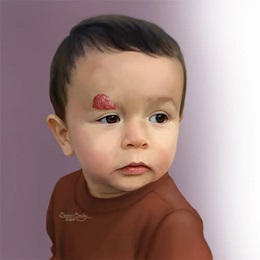Cardiac Amyloidosis
Amyloidosis is a collection of diseases caused when the protein amyloid abnormally deposits into one or more organs in the body. This can lead to disruption of normal organ functioning. Cardiac amyloidosis is the term used when amyloid protein deposits are found in the heart.
What You Need to Know
- The two kinds of amyloidosis most likely to damage the heart are light chain amyloidosis (AL) and transthyretin amyloidosis (ATTR).
- Treatment depends on the specific subtype of amyloidosis. It may include medication (oral, intravenous or subcutaneous), chemotherapy, immunotherapy and organ transplant.
What are the symptoms of cardiac amyloidosis?
Symptoms of AL and ATTR amyloidosis are determined by the organs involved in the disease. In cardiac amyloidosis, amyloid protein deposits in the heart muscle causes it to become thick and stiffened. Over time, this can cause the heart to become weak. Amyloid protein deposits in the heart can lead to:
- Congestive heart failure. Symptoms include shortness of breath during activity or while at rest, fatigue, fluid buildup in the abdomen and legs, and difficulty lying flat at night.
- Heart rhythm abnormalities. Symptoms include lightheadedness, dizziness, palpitations, shortness of breath, and fatigue.
- Valvular disease. If amyloid deposits in the valves in the heart, this can lead to leaky (regurgitant) or narrowed (stenotic) valvular disease. Specifically, ATTR amyloidosis has been found in some patients being treated for severe aortic stenosis. Symptoms include shortness of breath, exercise intolerance, lightheadedness and dizziness.
AL and ATTR amyloidosis can be associated with noncardiac symptoms or diagnoses related to deposits in other parts of the body, including:
- Carpal tunnel syndrome (especially bilateral carpal tunnel syndrome)
- Lumbar spinal stenosis
- Peripheral and autonomic neuropathy (numbness and tingling in hands or feet, lightheadedness, or dizziness)
- Orthostatic hypotension (low blood pressure upon standing)
- Poor appetite, diarrhea, or constipation
- Purple discoloration around eyelids (specific to AL amyloidosis)
- Easy bruising/bleeding (specific to AL amyloidosis)
- Enlarged tongue (specific to AL amyloidosis)
How is amyloidosis diagnosed?
Depending on the type of amyloidosis suspected, diagnostic testing may include:
- Blood work including chemistry panel and heart biomarkers
- Imaging studies including echocardiogram (heart ultrasound), nuclear medicine technetium pyrophosphate scanning, cardiac magnetic resonance imaging (MRI) and electrocardiogram (EKG)
- Tissue biopsy – in particular heart tissue biopsy
- Bone marrow biopsy
- Nerve conduction study
- Genetic testing
What are the most common types of cardiac amyloidosis?
The amyloidosis type is determined by the type of protein that abnormally deposits. The two most common types of cardiac amyloidosis are light chain (AL) and transthyretin (ATTR). However, many other types of proteins can also cause amyloidosis.
Light Chain (AL) Amyloidosis
Cause of AL Amyloidosis
The bone marrow is responsible for making blood cells in the body. One type of blood cell that bone marrow produces is a plasma cell. The function of a normal plasma cell is to produce immunoglobulin proteins, or antibodies, to help fight off infection. A specific part of this protein is called a light chain, either kappa or lambda.
In AL amyloidosis, the plasma cell and the light chain component make exact copies of themselves in an unregulated fashion. The light chains circulate in the bloodstream and can deposit in any organ. AL amyloidosis can overlap with bone marrow cancers, such as multiple myeloma. However, most patients with AL amyloidosis do not have overlap with a bone marrow cancer.
Treatment of AL Amyloidosis
Treatment is centered on symptomatic management of the disease, as well as suppression of further light chain production, usually with a combination of chemotherapy and immunotherapy. Sometimes, stem cell transplantation is considered with chemotherapy, but this usually is not a preferred path of treatment because of advances in and effectiveness of chemotherapy and immunotherapy alone. You may be eligible for a clinical trial if you have AL amyloidosis.
Transthyretin (ATTR) Amyloidosis
Cause of ATTR Amyloidosis
Transthyretin (TTR), a protein normally present in everyone, carries other proteins in the blood, including thyroid hormone and vitamin A. TTR is normally made up of four parts — a tetramer (which is shaped like a four-leaf clover). In ATTR amyloidosis, the tetramer becomes unstable and breaks into single parts (monomers). The TTR monomers are prone to depositing in specific organs and leading to organ dysfunction.
Types of ATTR Amyloidosis
There are two main forms of ATTR amyloidosis:
- Hereditary (hATTR)
- Wild-type (wtATTR)
In hereditary amyloidosis, an abnormal version of the TTR protein is produced, related to an inherited genetic change (mutation). This type of amyloidosis can be passed on to family members. Many genetic mutations have been discovered for ATTR amyloidosis, and the specific type of mutation is a major factor in determining disease course, such as which organs are affected. Most commonly, organs affected by hereditary ATTR amyloidosis are the heart and the nerves.
In wild-type ATTR amyloidosis, a normal version of the TTR protein becomes unstable as part of an age-related process. This type of amyloid is not passed on to family members. Wild-type amyloidosis most commonly affects the heart.
Treatment of ATTR Amyloidosis
Treatment is centered on symptomatic management of the disease as well as reduction in transthyretin deposits. Many medications are being studied to reduce transthyretin deposition, and the following have been approved by the Food and Drug Administration.
- ATTR stabilizers. These medications stabilize the TTR protein and prevent it from breaking down into single monomers. This prevents further deposition of the protein in organs.
- ATTR silencers. These medications decrease liver production of TTR.
- Organ transplantation may need to be considered for some patients with advanced disease that has progressed despite treatment with medications.
- You may be eligible for a clinical trial if you have ATTR amyloidosis.






